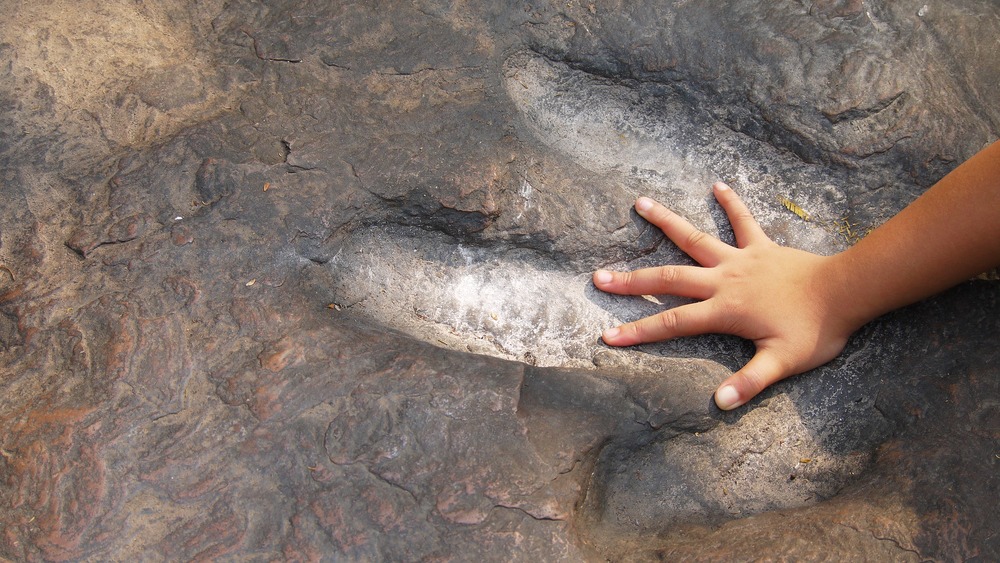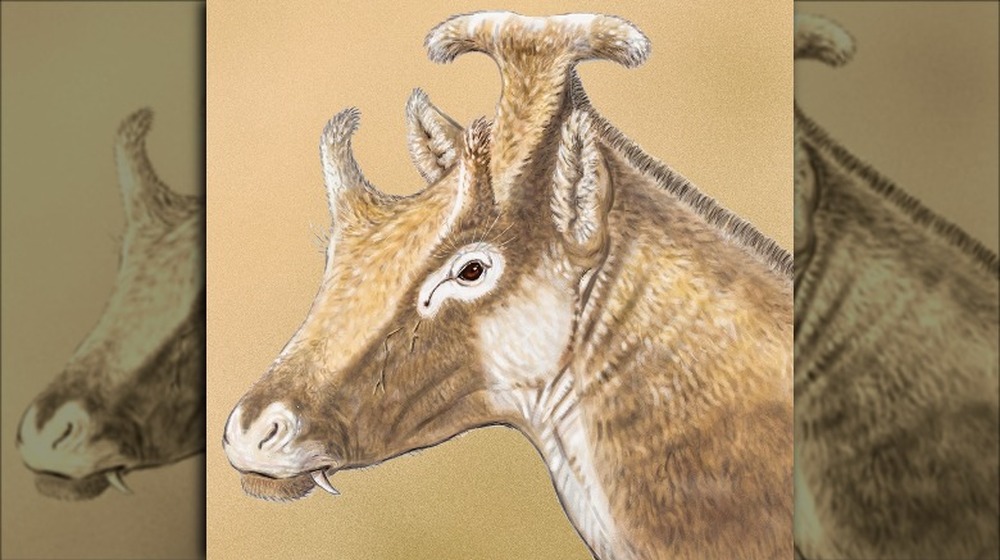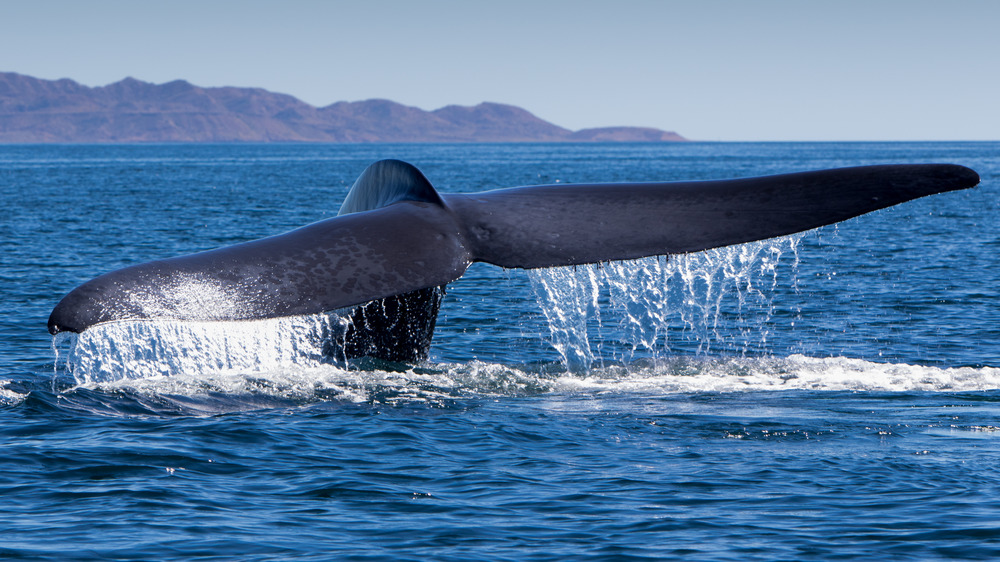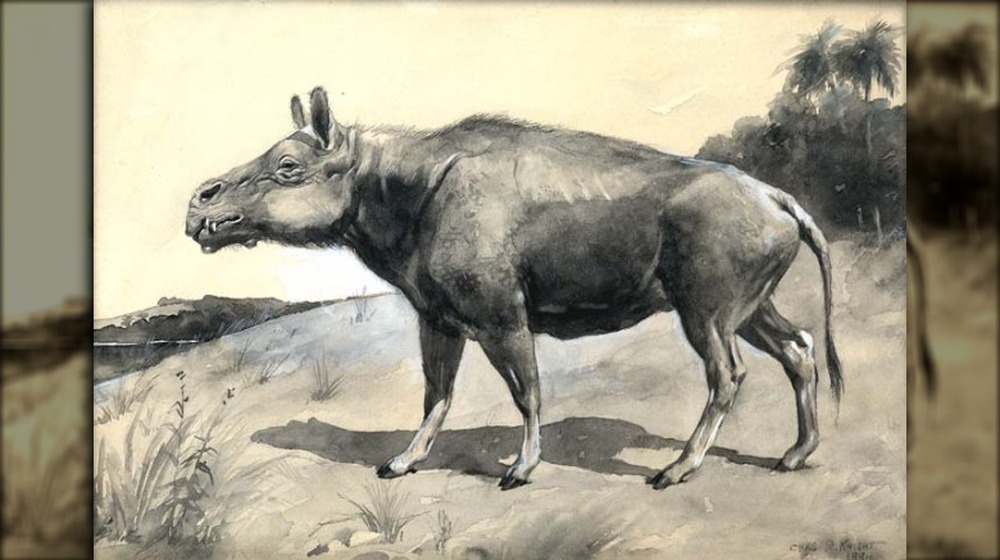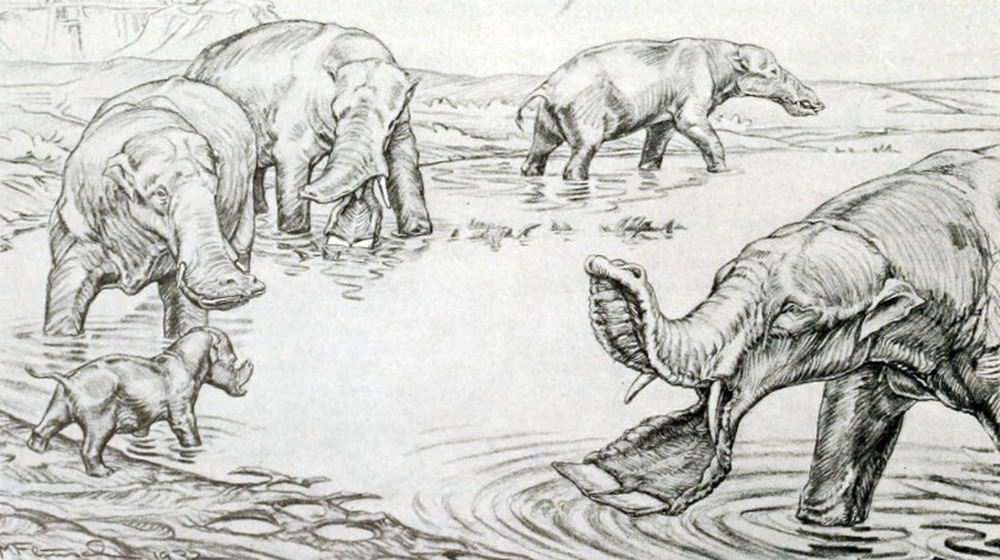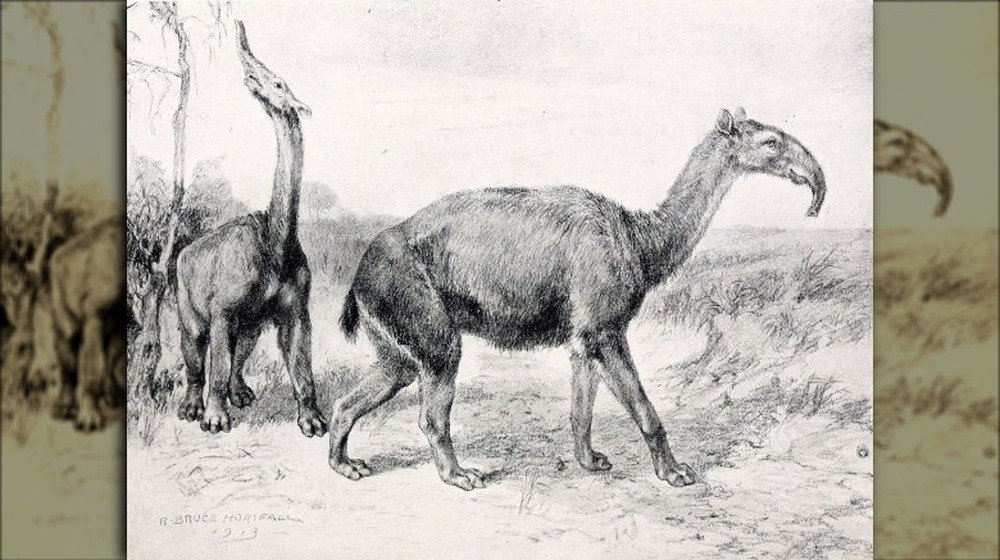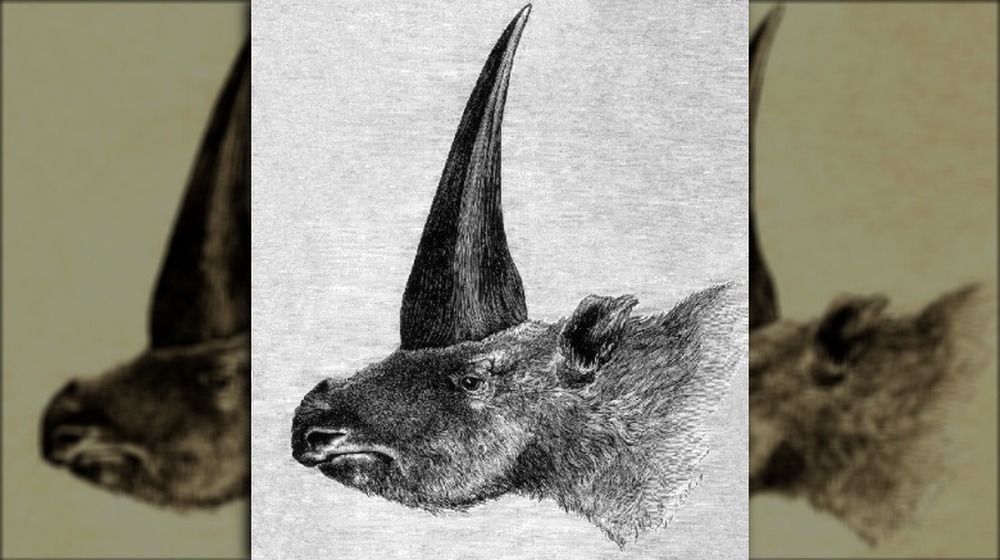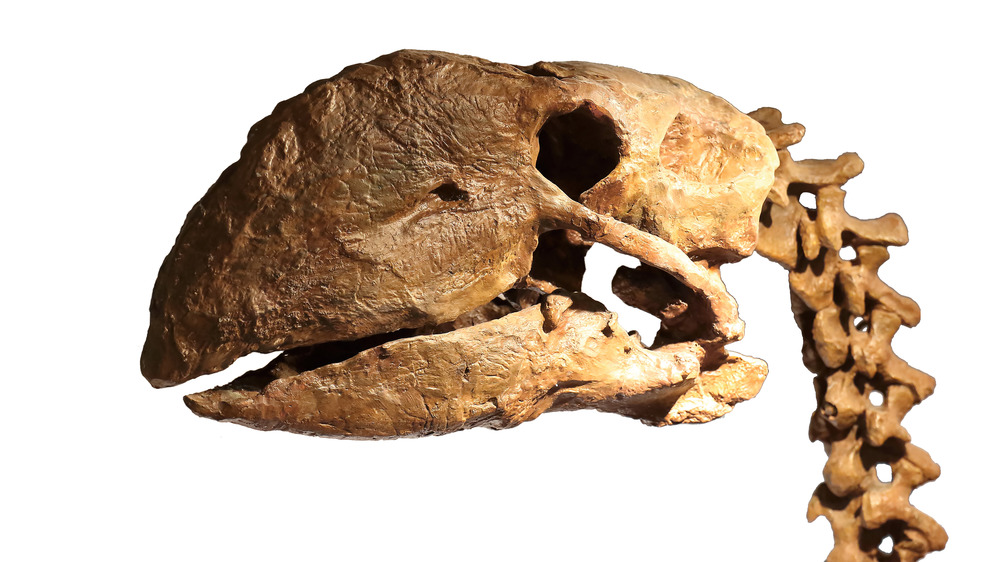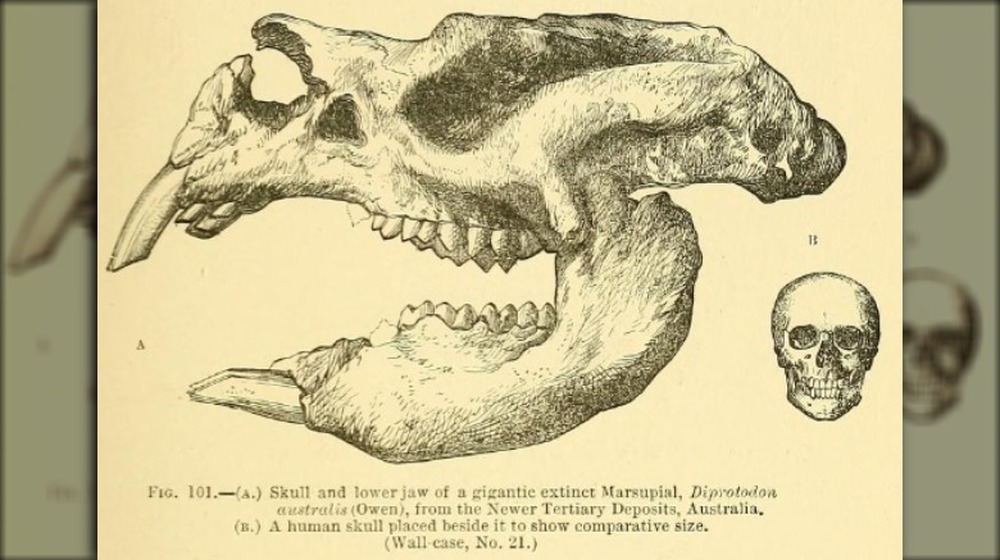Wildest Extinct Prehistoric Creatures That Aren't Dinosaurs
When it comes to all the fun things that kids get to learn about for the first time, dinosaurs are definitely some of the coolest. It's no wonder that so many kids — and their imaginations — are so enamored with the idea that these massive, thundering, lizard-beasts used to walk right where we're standing now.
But that also brings up an interesting question: just what is a dinosaur? That seems like it might be a silly question, but the Smithsonian found that it was surprisingly complex. The (sometimes difficult-to-define) category contains more than 1,000 species, and they have some things in common: laying eggs is involved in their reproduction cycle, they could regrow teeth, and they have a particular kind of hind leg.
That's not only surprisingly specific, but it also doesn't include a ton of other prehistoric creatures. Sure, dinosaurs are cool and all, but it turns out they must have had a really good PR person, because they absolutely stole the limelight from scores of other weird and wacky now-extinct animals. Some are terrifying, some look like they were designed by Lewis Carroll, and others? Well, it's hard to imagine how some of these animals even worked at all.
The gorilla-horse hybrids
Picture a gorilla. (Seriously, just go with it.) Now, picture it's Halloween, and this little gorilla really wants to go dressed as his favorite character from My Little Pony. So, mama gorilla makes a Twilight Sparkle costume to turn him into as much of a pony as possible... but just like no one ever actually believes Angela from Accounting is actually a cat, everyone can see there's a gorilla in that horse costume.
That's a weirdly accurate description of a group of creatures called the chalicotheres. According to Earth Archives, they were the ancient ancestors of horses, had distinctly horse-like necks, but also had short hind legs and long front legs that gave them a stance similar to that of today's gorillas. The weirdness doesn't end there: some of the species within the chalicothere family had massive, sharp claws. Wear patterns of their claws — coupled with their huge teeth suited to grinding plants rather than tearing flesh — seem to confirm they were vegetarian grazers like horses... but also, some species seem to have walked like gorillas: balanced on the knuckles of their "hands." Researchers also think they tended to sit like pandas as they ate, which is adorable.
Research published in the History and Philosophy of the Life Sciences says that their remains confused the heck out of scientists for a long time, and it wasn't until they started taking modern animals and playing a sort of mix-n-match game that anything about them started to make sense.
The giraffe with Amidala's hair
While the world has been desensitized to the actual ridiculousness of Princess Leia's cinnamon bun hairstyle, the Star Wars prequels took the weirdness to a whole new level (in more ways than one). The hype around the movies was palpatine... er, palpable, but since then there's been a bit of snickering, directed in part toward the downright bizarre hair and costumes sported by Queen Amidala.
Paleontologists apparently like Star Wars, too, because when is came time for Israel Sanchez to name a newly discovered, long-extinct, giraffe- and deer-like mammal, they called it Xenokeryx amidalae for a very good reason: it had some headgear that was just as goofy. According to National Geographic, the creature — which thrived around 16 million years ago in the area we now know as Spain, and went the way of the Dodo about 4.9 million years ago — looked something like a saber-toothed giraffe with furry horns (also like a giraffe's) sticking out from over the eyes like some sort of built-in baseball cap with the brim turned up. They also sported another furry horn — more technically called a ossicone, and this one shaped like a "T" — straight up from the back of the skull in reverse unicorn fashion.
As if that's not weird enough, this prehistoric European giraffe is one of an entire family of creatures known as the palaeomerycids, recognizable by their equally weird cranial decorations.
The innocently-named short-faced kangaroo
Even normal kangaroos are weird, so let's get really freaky with them and talk about the giant kangaroos that inhabited Australia about the time of the last Ice Age. They weren't just giant kangaroos, so let's make some adjustments. Take a regular kangaroo, and enlarge it so it's around 6.5 feet tall and weighs about 400 pounds. (That's at the high end, says the Australian Museum.) Next, put a human head on it.
No, really. The members of the subfamily Sthenurinae had strangely human faces: they had heads with flat-fronted skulls, a distinct chin, wide foreheads, and eyes set in the front of the skull instead of on the side. They also had well-defined cheekbones, which got some researchers thinking. While strong cheekbones will get humans on the cover of magazines and starring roles in blockbuster films, what was the point for a kangaroo?
D. Rex Mitchell of the University of Arkansas did some amazing work (via The Conversation) to find out what was going on here. He selected one version of the sthenurine family tree, the Simosthenurus occidentalis. It's a little smaller than our aforementioned gargantuan friend, but still, he found that their skulls allowed them to not only bite down with incredible force, but with enough force that they could comfortably nom away on entire tree branches. That, in turn, opened them up to a food source that other creatures wouldn't have been able to eat, but still: yikes.
A real-life Leviathan
Anyone who can safely and comfortably get a good night's sleep can probably only do so because they're not familiar with the absolutely terrifying creatures that live in our planet's oceans. In 2010, Nature published a story on a shocking discovery that had been made in — of all places — the desert of Peru. Researchers had uncovered enough of the fossilized remains of a creature to estimate that it had been about 60 feet long, and some of the teeth discovered with the skull were 14 inches long. The verdict? A huge whale, worthy of a name of Biblical proportions.
The creature's name is wholly appropriate: Livyatan melvillei. (National Geographic notes that it was changed from the original Leviathan.) And as for melvillei? Sorry, but this thing would have eaten Moby Dick for lunch. Literally.
While most of today's massive whales are suction feeders, these bad boys were definitely not the type to just drift along slowly and sift their food from the oceans. These were hunters that preyed on other massive whales, and they had the power to do it. ThoughtCo. says they weighed somewhere around 50 tons, and while the prey-of-choice was likely things like prehistoric dolphins, it was also likely to have tangled with another ancient monster: the megalodon.
Killer pigs from hell... that weren't really pigs
It's undeniable: the entelodont looks like a pig. A giant, angry pig with a head that seems way too big for the matching body, LiveScience says they're widely known as "hell pigs," even though they weren't actually pigs (and more on that in a minute.) If there's any prehistoric creature that looks like it might have come straight up for Tartarus itself, it's the hell pig. Those giant heads could reach sizes of up to three feet long, and they accounted for as much as 45 percent of the creature's entire body. Not creepy enough? Those skulls were definitely powerful enough to crush bone, but they have the teeth of animals that eat mostly plants, and only occasionally meat.
Fossilized remains of entelodonts suggest that a good portion of the bones that got crushed in a hell pig's mouth were the skulls of other hell pigs. Scars dug into entelodont bones — along with defensive bones structures that seem to have developed to protect the softest, most vulnerable parts of a pig's face — seem to suggest that fights were common.
Now, as for that whole "hell pig" thing? It's a bit of a misnomer. They're actually more closely related to modern animals like hippos, and here's some more food for thought. It's probably for the best that they disappeared around 19 million years ago, because they could reach up to 2,000 pounds — about the same size as a Clydesdale.
Shovel-tusker or saw-tusker?
The platypus has got to be one of the most hilariously weird modern-day animals we have, and it shares at least part of its name with the Platybelodon. There's a bit of similarity in appearance, too — mostly in the face. Let's explain. First, imagine an elephant. Then, remove the trunk and replace it with an extra set of super-elongated, flat tusks. Then, use them to construct a massive, scoop-like mouth that would be the envy of anyone who's ever designed a bulldozer.
The Platybelodon's weird mouth has perhaps unsurprisingly been quite the subject of speculation. When the remains of the creature were first assembled and cataloged in the 1920s, it was assumed it lived in water and used its mouth to dredge the bottom of lakes, swamps, or rivers for vegetation. That makes a lot of sense, right?
Only, according to Wired, that's not at all what they did. In 1992, researchers took a look at the wear patterns on some Platybelodon tusks, and rethought the whole theory. Now, it's believed they used their tusks as saws, cutting down plants and potential predators alike. That theory has been supported by the discovery of structures within the tusks that made them much stronger than the tusks of modern animals, and there's still one thing that no one seems to be able to agree on. Did they have trunks? Fleshy trunks wouldn't have turned into fossils, so it's entirely possible that this weird-looking creature actually looked even weirder.
The animal that baffled Darwin
If there's anything that can be said about Charles Darwin, it's that he liked to be able to categorize things into neat little pockets of information. But there's always got to be that thing that doesn't fit neatly into any category, and for Darwin, that was the Macrauchenia patachonica.
That awkwardly named creature was one of a number of hoofed animals that once roamed South America, and disappeared only about 10,000 years ago. Darwin discovered fossils in Argentina when he was on his famous world tour, and he had no idea what to make of them. The animal had been about the size of a rhino but had the teeth of a rodent, a massive head, short legs, a long neck, and a nose that grew out of its face from right between the eyes.
At first, The Washington Post says researchers had decided it was some sort of giant llama, but no one was really 100 percent convinced. Fortunately, modern science has come to the rescue. In 2017, DNA from remains discovered in a Chilean cave were analyzed by the American Museum of Natural History and Germany's University of Potsdam. Surprisingly, they found that the creature is a distant relation of literally none of the animals in the aforementioned description: go back about 66 million years, and it sits at a branch of the early ancestors of horses.
The Siberian unicorn
The idea of a Siberian unicorn might conjure up images of a shaggy yet majestic white horse with a horn, but that's not entirely what they were. The best way to describe them is with a little bit of comparison. The woolly mammoth is pretty familiar as a super hairy, northern version of an elephant. Now, make a rhino version, and give it just a single massive horn growing out of the center of the skull. Also — just because — make it bigger: up to around 7,700 pounds. (For comparison, the San Diego Zoo says the biggest of today's rhinos weighs around 5,000 pounds.) Presto! The Siberian unicorn.
For a long time, it was believed that this massive beast went extinct 100,000 years ago, but when the Smithsonian looked at more recent studies, they found radiocarbon dating tests seem to prove that they were still around just 39,000 to possibly 29,000 years ago. And that means it's entirely possible our ancestors — early humans, and Neanderthals — existed at the same time these surprisingly lithe and agile ancient rhinos.
It also suggests they didn't have a pleasant end. About 40,000 years ago, a mass extinction event killed some of the earth's other megafauna — including the woolly mammoth. It's now believed that the Siberian unicorn died in the same event — called the Quaternary extinction event — which was the result of climate change, increasingly cold temperatures, and the disappearance of their main food sources.
The 'roly-poly' prehistoric bunny
Going back to the age of the dinosaurs, and the days that the world was populated by megafauna, and there's a lot of talk of claws and bone-crushing jaws being outfitted in bodies that weigh the same as eight to 10 average-sized horses. That's the stuff of nightmares.
But there's good news! There were also ancient, prehistoric rabbits that weren't terrifying at all. According to National Geographic, the official announcement of the discovery of Nuralagus rex came in 2011, although fossils had been found much earlier. The bunny — which lived on Spain's Minorca island, around 4 million years ago — is estimated to have weighed around 26 pounds. It's classified as a rabbit because it shares a skull and teeth with modern-day rabbits, but that doesn't mean any time traveler to prehistoric Spain would necessarily see it and automatically name them all "Peter Fuzzy-Bottom." Rabbit evolution expert Brian Kraatz of the Western University of Health Sciences explained it this way: "... this is a rather typical rabbit head stuck on an atypical rabbit body."
Meaning? For starters, they had as much hopping ability as a Sherman tank — which researchers inferred from their inflexible spines. Examination of the rabbit's skulls suggest teeny-tiny eyes and short ears, which is the opposite of what someone might expect when they picture a rabbit. Best of all, they were described as "roly-poly," a physique they developed in part because of a lack of predators and plenty of food. Prehistoric bunnies had the life.
Australia's Demon Ducks
Of course the creatures known as Demon Ducks lived in Australia, that kind of goes without saying. According to the Australian Museum, the Dromornis planei belongs to an extinct family of birds that — in spite of being flightless — have a lot in common with modern-day ducks: hence, the informal name of the Demon Duck of Doom. They lived to terrorize Australia for a long time, first showing up in the fossil record about 55 million years ago, and only disappearing around 50,000 years ago. There's been a ton of fossils discovered, but there's still a lot that's just not known about what they were — including whether or not they had wings. (The general consensus is that they had tiny ones.)
The Demon Duck averaged about 600 pounds, and stood somewhere around eight feet tall. Based on where the fossils have been found they seem to have gravitated toward water supplies like rivers and floodplains, and also seem to have been one of the favorite foods of crocodiles, which have been around forever and will almost definitely outlast mankind.
Paleontologist Travis Park notes that there's actually different species within the group known as dromornithids, and it's still not known whether or not they ate mainly plants or meat, and what ultimately led to their extinction is also still a mystery.
South America's aquatic sloths
Sloths are just one of those animals that are inherently funny, and it's a wonder they've managed to survive at all. The strange thing is that they've been around for a shocking amount of time, and there's at least one kind of sloth that was arguably even lazier than the ones that live in the trees.
National Geographic says that today, sloths spend the majority of their time in the trees, and come down to the ground to see what's what only on the rare occasion. But rewind to between five and eight million years ago, and five species of sloth had a different idea of what living the easy life meant.
Researchers from the National Museum of Natural History in Paris confirmed that these ancient sloths were actually deep-diving swimmers, and they had adaptations that made it super easy. While the bones of animals that live on land are filled with cavities, sloth bones were solid. They also sported beaver-like tails and legs bones that had adapted to swimming, making it entirely possible that these ancient beach sloths spent much of their time at the bottom of the ocean, grazing on vegetation, and returning to land only to sun themselves. There's no word on where the rest of us can sign up for that lifestyle.
The largest marsupial ever
Wombats are pretty darn cute. They stand about knee-high on a person, can weigh between 30 and 80 pounds, and spend their lives toddling around Australia and looking adorable for their features on social media.
According to Nature, they looked pretty different 300,000 years ago. The ancient ancestors of today's wombats were called Diprotodon, and they didn't fit inside a pillowcase: they were about the size of a rhino, weighed around 6,000 pounds each, and were just as stocky as their modern-day counterparts. They also migrated.
Researchers from the University of Queensland were able to take 300,000-year-old teeth and examine them for isotope signatures that would give some insight into just what these massive creatures were eating. They found cycles: each year, the ancient wombat would migrate in a pattern that covered about 125 miles. It seems as though they were following rains (and food sources), making them the only marsupial known to migrate.
